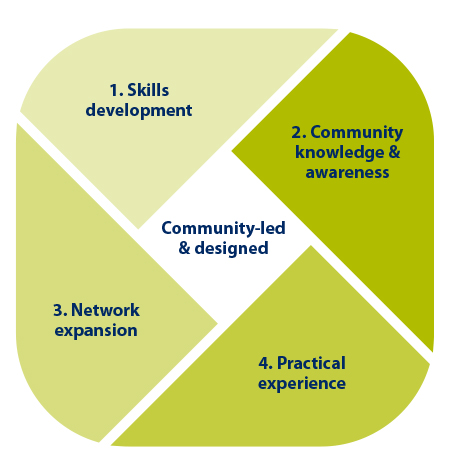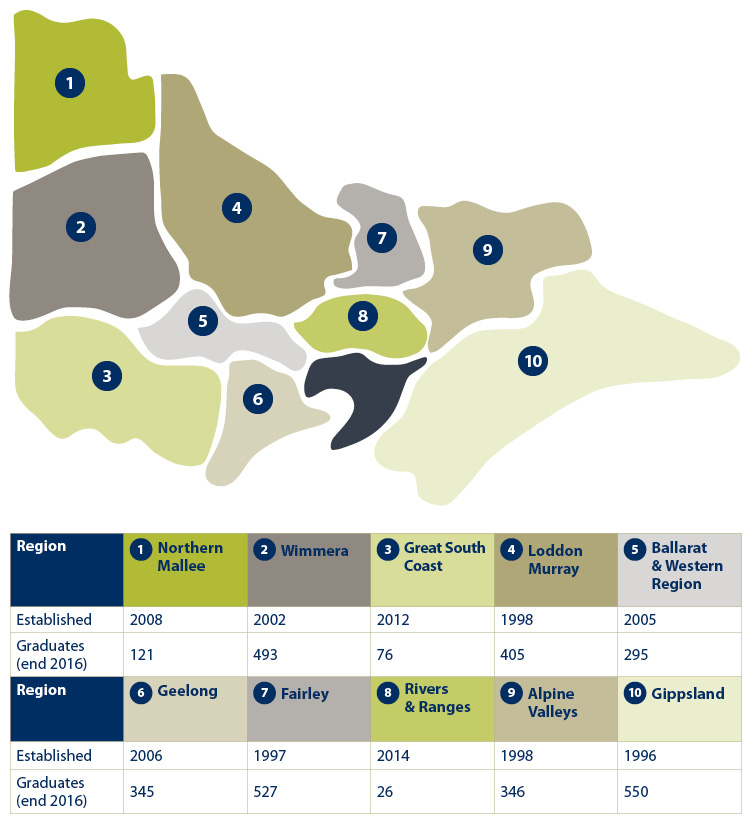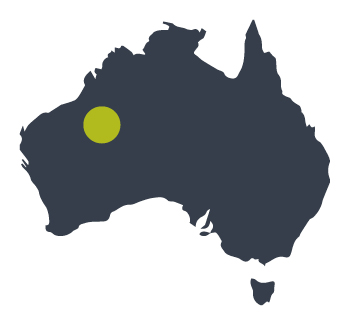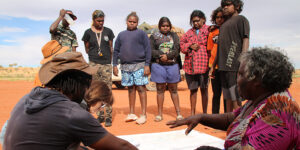
Features of successful community leadership programs
What do successful community leadership programs look like? SVA shares insights from programs it has reviewed.

- For community-based solutions to local issues to succeed, community participation and leadership is required.
- SVA has evaluated a range of community leadership programs in regional Victoria and the Western Desert of WA. These successful programs were community-led and established to respond to specific needs of the community.
- They all also feature four components: leadership skills development, community knowledge and awareness, network expansion and practical experience.
New approaches to strengthen and grow regional and remote communities are increasingly being explored. The success and sustainability of these approaches can be influenced by a community’s leadership capacity.
In this article, we describe successful community leadership development programs through which governments, social purpose organisations and communities can help build this leadership capacity.
The article is based on SVA Consulting’s evaluations of leadership development programs in Victoria (supported by Regional Development Victoria) and in the Western Desert in Western Australia (run by Kanyirninpa Jukurrpa).
For example, one of the programs was the Loddon Murray Community Leadership Program set up in 1998 to help the community access local agricultural opportunities. Covering 59,000 square kms in Victoria’s north, the program runs for 23 days over 10 months each year. It includes opening and closing retreats, trips to Melbourne and Canberra, and skills and community issues days. Participants also design and implement a community project that allows them to build on what they have learnt during the program.
Sixty seven per cent of the program’s graduates said they are more actively aware and influential within their community because of the program, and 43% said they were promoted or changed roles because of the program and what they learnt.[1]
Community-led approaches
Nearly 8 million of Australia’s 24 million people live outside of the nation’s metropolitan capital cities in regional and remote communities.[2] Increasingly these communities are dealing with unique social and economic hardships. In many cases, people in regional and remote Australia experience higher (and rising) unemployment rates, lower life expectancy and lower educational outcomes, than those living in urban Australia.[3]
It is increasingly recognised that approaches need to be community-led to ensure their effectiveness and sustainability.
Communities, governments and social purpose organisations are seeking policies and projects that can promote social and economic development in these areas. It is increasingly recognised that approaches need to be community-led to ensure their effectiveness and sustainability. A community taking a central role helps to ensure solutions are adapted and developed for the community’s specific characteristics. It can also contribute to the community’s greater sense of ownership of the solutions and leverage its strengths, existing networks and infrastructure.
Good community leadership needed
Good community leaders have a deep understanding of community issues, leadership skills to bring community members together, broad networks to draw on for input and support and the self-confidence to engage and lead discussions. These leaders help build a community’s capacity to contribute to its own development; they provide important input during the development of solutions, help galvanise community support and shepherd through their effective implementation.[4]
A lack of investment in building this capacity and limited opportunities for leaders can create a leadership void.
Many regional and remote communities struggle to develop and retain this leadership capacity, both in quantity of leaders and breadth of their skills. A lack of investment in building this capacity and limited opportunities for leaders can create a leadership void. A growing distrust in many regional and remote communities between individuals and their institutions along with declining involvement in voluntary work suggest that this void already exists.[5]
Community leadership programs that build capacity
There is great leadership potential in these communities but it needs to be stimulated and fostered through more conscious investment in leadership skill development. Through some of SVA’s recent work we have seen community leadership development programs successfully tap into and grow this potential.
Critically, these programs are community-led and designed for the specific needs of the community.
These programs are designed and run specifically to build community leadership. They provide an opportunity to aspiring leaders in regional and remote areas, where leadership programs traditionally run by universities or other institutions are not available, accessible or relevant.
Critically, these programs are community-led and designed for the specific needs of the community. This means that the program’s management can and do adjust the content and structure of their programs to meet the changing community and participants’ needs.
We have seen four components in these programs, used to different extents by each program but working together to develop leadership capacity:
1. Skills development
Building leadership skills such as leadership styles and stages of leadership, self-awareness, personality profiling, team dynamics, public speaking, time management, project management, decision-making, coaching and mentoring.
2. Community knowledge & awareness
Growing a better understanding of their own and other communities and the myriad of related issues.
3. Network expansion
Developing relationships within the cohort but also with other leaders and institutions in their community.
4. Practical experience
Learning experientially through immersions, workshops, projects and reflections. This allows participants to implement and build on what they have learnt.

These components were also seen in our review of the structure of international leadership programs. It reflects a growing consensus among experts that combining aspects of established strategies and approaches to leadership development (training, mentoring, personal/self-development and experiential learning) is the most effective way for a leadership program to build the leadership capacity of its participants.[6]
The programs that SVA recently evaluated – the Regional Community Leadership Programs in Victoria and the Martu Leadership Program with the Martu community in central Western Australia – provide useful examples of how these components are applied in practice. They also demonstrate how these programs reflect the specific contexts of the communities they are designed for.
Regional Community Leadership Programs (RCLPs) supported by Regional Development Victoria
Since 2011, Regional Development Victoria (RDV), the state government’s lead development agency for rural and regional Victoria, has financially supported 10 Regional Community Leadership Programs (RCLPs). Part of its Stronger Regional Communities Plan, this support aims to enhance economic growth and sustainability in these areas.
The programs are also supported by the Victorian Regional Community Leadership Programs Secretariat (VRCLP) that helps facilitate collaboration, learning and support across the RCLPs. This helps improve the quality of all the programs and strengthen connections and networks across regional Victoria.
The RCLPs provide opportunities to aspiring community leaders across all regions outside of Melbourne (as shown below).

All the RCLPs were set up independently, and were locally-led and designed. This ensures the program’s content and activities are specific to community issues and needs. Each program was established by the community after identifying a specific community need and has developed over time to reflect changing demands from the community.
One example of this is the Rivers and Ranges Community Leadership Program was established in 2014 in response to the 2009 Black Saturday bushfires that devastated Victoria. The affected communities observed that the leaders that had stepped up to help rebuild their communities were suffering ‘volunteer fatigue’. Many of these leaders took on these roles without the skills and networks needed for support. After extensive engagement with stakeholders, the community developed a leadership development program to create a more resilient community to help address this issue.
The RCLPs aim to build the skills, diversity, participation and number of leaders from government, business and community sectors who can affect positive change in their communities and workplaces. Typically, they run for 10 months. Overall, they have trained more than 3,200 graduates. Some programs have been operating for over 20 years, one for only three years.
All the programs draw on the four core components identified above. Common features are ‘program days’ where participants learn about key community issues and build their networks, seminars about leadership skills, and practical projects where participants apply the skills they have learnt.
The focus on and content of these components differs greatly across the programs reflecting the needs of the region and the participants involved. For example, ‘program days’ differ greatly across the 10 programs reflecting the issues faced by that community and key local industries. These are typically decided on after much consultation with participants, employers, local government and the program management team. For example, the Gippsland Community Leadership Program includes a focus on the power generation industry because of its economic significance to the area; and the Leadership Great South Coast program, which covers the Great Ocean Road, includes a program day on eco-tourism.
… success stems from the synergy of the diverse group of people in each program year combined with the skills it instils.
RCLPs’ participants see significant and valuable increase in their knowledge, skills, confidence self-awareness and expanded personal and professional networks.[7]
As Beth King, 2013 Graduate of the Leaders for Geelong program said, “It gave me an overview of the issues, organisations and people who are helping Geelong develop and thrive in a global environment where uncertainty is the only certainty.”
Tammy Atkins, a Graduate of the Alpine Valleys Community Leadership Program, said ‘The program’s success stems from the synergy of the diverse group of people in each program year combined with the skills it instils. I appreciate that the program delivered a view of the bigger picture for our region…’
Many graduates go on to engage more with community organisations and local governments and take ‘higher impact’ roles within these organisations. For example, during the 2016 Victorian Council Elections, 34 of the 50 regional local government areas had at least one nominee who was a graduate of an RCLP.
… much of the debate was driven by program graduates, and demonstrated their understanding of the issues and enhanced leadership skills.
Many graduates also became ‘informal leaders’ – they don’t hold a formal leadership position but support and complement formal leaders.[8] ‘Informal leaders’ play an important role helping to drive community discussions on issues and their solutions that can inform formal decision-making.
For example, a member of the Gippsland program’s advisory committee had seen social media discussions about the impact of, and potential response to, an imminent closure of the Hazelwood power plant in the Latrobe Valley. She noticed that much of the debate was driven by program graduates, and demonstrated their understanding of the issues and enhanced leadership skills. As a result, the tone of the discussion was calmer and more civilised than she had expected.
Kanyirninpa Jukurrpa’s (KJ) Martu Leadership Program (MLP)
The Martu Leadership Program (MLP) is a focused community education and development program, designed to build broad-based capacity and create opportunities for Martu communities in the remote Western Desert. It is run by Kanyirninpa Jukurrpa (KJ), a Martu organisation established in 2005 to look after Martu culture and help build sustainable Martu communities.

KJ began the program, in 2014, after seeing that its current programs did not involve Martu learning about and engaging externally with mainstream Australia, or gaining understanding of what it means to be Martu in the context of 21st century Australia. Since its establishment almost 100 Martu have been able to participate in the program.
The program aims to support Martu men and women to build knowledge, skills, practical experience and relationships. These will help the Martu community to engage effectively with government and other mainstream stakeholders, address social issues, and develop economic opportunities to shape a new future for Martu.
The program features the same four key components (identified above) but once again they show up in different ways reflecting the Martu community’s goals.
The program consists of:
- coursework and study trips focused on leadership skills and understanding the issues affecting Martu;
- giving presentations, public speaking, and chairing meetings; and
- trips to Perth, Canberra, Sydney and Melbourne to be immersed in non-Indigenous culture.
Apart from the city trips, the program is delivered on-country in Newman and remote communities in Martu country.
… the program has evolved in response to the wider community’s emphasis on building the group’s collective leadership.
Since it began, the MLP has developed organically through the input of participants and the wider Martu community so that it meets their needs and realities. For example, the program has evolved in response to the wider community’s emphasis on building the group’s collective leadership. It also now provides a central role for mentors and elders to strengthen their relationship with aspiring leaders.
The program has been an overwhelming success in building the leadership capacity of its participants and the community more broadly. It has empowered Martu, and improved their confidence, knowledge and social connections with each other and mainstream Australia.[9]
Slim, a Martu man who took part in the program, spoke of how the program gave him confidence to actively participate in meetings with other community organisations.“This leadership, it’s really strong. We’re getting all our ideas from leadership. If I get on their board I’m going to change everything.”
It has inspired efforts to change the way the criminal justice system and Martu interact.
Importantly, the program has already increased collaboration between the Martu and non-Indigenous people. This gives the Martu a greater voice about what is happening in their communities.
Another example is the ‘two-way learning’ with the Pilbara Magistrate, Aboriginal Legal Service of WA and Herbert Smith Freehills. This has allowed Martu to better understand the mainstream legal system and give insights into the Martu culture to those working in the system. It has inspired efforts to change the way the criminal justice system and Martu interact.
Investing to develop community leadership
The Regional Community Leaderhsip Programs and the Martu Leadership Program exemplify how community leadership can be developed through community-led programs that take a comprehensive approach to leadership development. While a stronger evidence base is still needed to quantify the impact on the wider community’s development, the programs’ impact on participants and other stakeholders (e.g. employers) appears to be significant.
Intentionally investing in expanding a community’s leadership capacity has the potential to improve the effectiveness and sustainability of a community’s solutions.
Author: Dan Code
[1] VRCLP, Alumni Survey 2013 (unpublished).
[2] Australian Bureau of Statistics, 2017, Regional Population Growth Australia, 2016.
[3] Commonwealth of Australia, 2016, Progress in Australian Regions Yearbook 2016, pg 18-21, 65, 98.
[4] Robert Chaskin, 2001, Building Community Capacity: A Definitional Framework and Case Studies from a Comprehensive Community Initiative.
[5] Commonwealth of Australia, 2016, Progress in Australian Regions Yearbook 2016, pg 66,158,172,187.
[6] United Way of Calgary, 2010, Community Leadership Development, Discussion Paper.
[7] VRCLP, Alumni Survey 2013 (unpublished).
[8] United Way of Calgary, 2010, Community Leadership Development, Discussion Paper.
[9] The Martu Leadership Program, Evaluation of a pilot program using the Social Return on Investment (SROI) methodology, April 2017.







